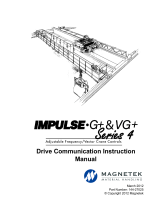
Installation, Operation and Maintenance Manual
VCIOM-16741-EN Rev. 0 November 2021
Input and Output Data 11
Section 4: Input and Output Data
4.2.2 Status
Register number: 258, address 0101Hex
Data format: 16 bit (Biteld)
Table 8.
Bit no. Function Description
Bit = 0 Bit = 1
0 READY - Actuator is ready.
1 END POSITION OPEN - End position OPEN reached (under consideration of switch-off
mode (torque or travel dependent)).
2 END POSITION CLOSE - End position CLOSE reached (under consideration switch-off
mode (torque or travel dependent)).
3 TRAVEL OPEN - End travel OPEN reached (under consideration of switch-off
mode (torque or travel dependent)).
4 TRAVEL CLOSE - End travel CLOSE reached (travel dependent).
5 TORQUE OPEN - Power-off torque in opening direction exceeded.
6 TORQUE CLOSE - Power-off torque in closing direction exceeded.
7 MOTORTEMP. Motor temperature sensor signal (overheat).
8 OPENING - Actuator moving in OPEN direction.
9 CLOSING - Actuator moving in CLOSE direction.
10 LOCAL - Switch in LOCAL mode position.
11 REMOTE - Switch in REMOTE mode position.
12 LOCK OPEN - Latched OPEN command with highest priority.
(Refer to Command bit 10 und 12)
13 LOCK CLOSE - Latched CLOSE command with highest priority.
(Refer to Command bit 10 und 12)
14 LIVEBIT 1 Livebit1 toggles with 1 Hz.
15 LIVEBIT 2 Livebit2 is a copy of the watchdog toggle-bit. (Refer to command Bit 7).
4.2.3 Actual Torque Value
Register number: 259, address 0102Hex
Data format: 16 bit, only the lowest 8 bit (Bit 7: Direction OPEN; Bit 6 - 0 : 0 - 100
corresponding to 0 - 100%) are in use.
Other bits are reserved for future use and have to be set to zero.























